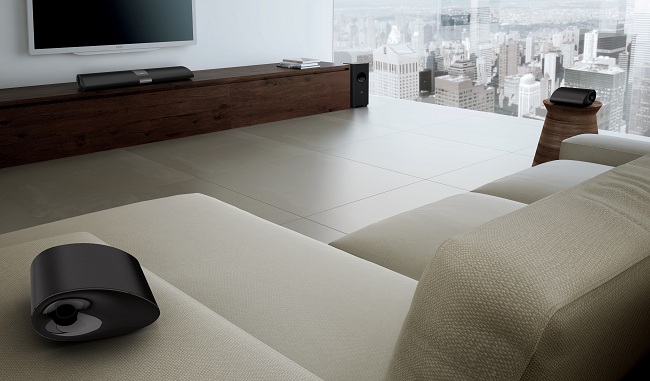 While there have been tremendous advances in sound bar technology over the past few years, the fact still remains that even the best products are primarily limited to a 3.1 experience. The closest we’ve come to a true 5.1 sound bar system are two soon-to-be-released Vizio systems with wireless surrounds and the recently launched Sonos PlayBar, which requires the addition of a couple of Play:3 speakers and the Sonos Sub. But even though those systems offer surround speakers with wireless audio delivery, they aren’t truly wireless. You’ve still got to plug the the speakers in to a power source to juice up the built-in amplifiers. What we’ve really been pining for is a surround system with truly wireless surround speakers – ones which pack a built-in rechargeable battery inside to power built-in amps – but up until now such a product has eluded consumers. With the launch of the Philips Fidelio HTL9100 sound bar, the future has finally arrived.
While there have been tremendous advances in sound bar technology over the past few years, the fact still remains that even the best products are primarily limited to a 3.1 experience. The closest we’ve come to a true 5.1 sound bar system are two soon-to-be-released Vizio systems with wireless surrounds and the recently launched Sonos PlayBar, which requires the addition of a couple of Play:3 speakers and the Sonos Sub. But even though those systems offer surround speakers with wireless audio delivery, they aren’t truly wireless. You’ve still got to plug the the speakers in to a power source to juice up the built-in amplifiers. What we’ve really been pining for is a surround system with truly wireless surround speakers – ones which pack a built-in rechargeable battery inside to power built-in amps – but up until now such a product has eluded consumers. With the launch of the Philips Fidelio HTL9100 sound bar, the future has finally arrived.
The Fidelio HTL9100 is the first sound bar to feature detachable battery-powered wireless surround speakers that, when removed, automatically switch the system from virtual surround sound to 5.1 channel surround sound. The HTL9100 also comes with a wireless subwoofer, which has quickly become the norm in sound bar systems.
The speakers operate via Philips’ proprietary wireless audio technology, leaving consumers free to place them wherever they like. With the HTL9100, the audio is uncompressed and the frequency the surround speakers operate at is different than that of Wi-Fi and Bluetooth, which means no network interference.
When fully charged, the detachable surround sound speakers offer up to 10 hours of play time and automatically recharge when connected to the main unit. The Philips Fidelio sound bar includes an intelligent orientation
For added convenience, the Fidelio sound bar includes two HDMI ports that allow users to easily link their media system or games console. The HTL9100 also includes an optical digital input which is how most consumers with multiple sources are likely to connect everything. via the digital output on their HDTV. For music playback it connects wirelessly to any Bluetooth-enabled device, so the only wires needed are for power and a link to your HDTV.
The Philips HTL9100 sound bar goes on sale in May for $800, and while that is significantly less than the $2,000 Sonos is charging for a 5.1 PlayBar system, Philips still faces some stiff competition from the likes of Vizio, Atlantic Technology, and Definitive Technology, all of which have some excellent products doing very well in the marketplace. The battery-powered design is still unique, and we hope that the introduction of the Philips sound bar will push other manufacturers in a similar direction; offering genuine 5.1 surround sound in a wireless package that people can actually afford.
See the HTL9100 in action in the Philips video below.


